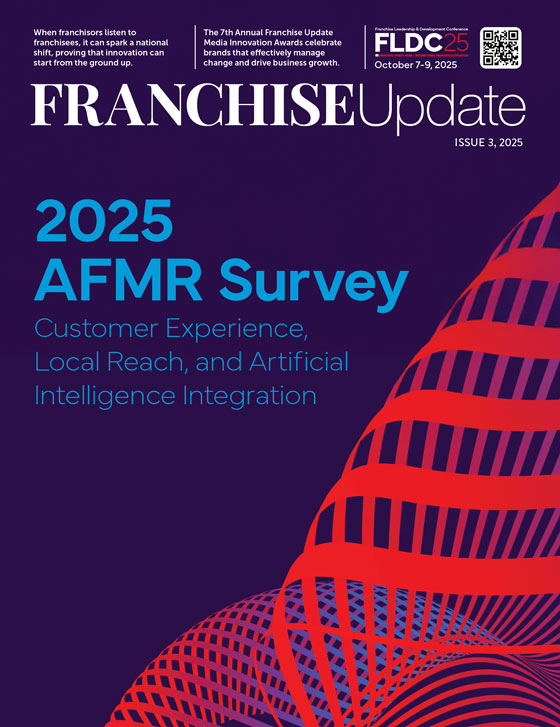The Science of Site Selection: Connect with the Right Brand, Operator, and Location

For decades, real estate pros could point to traffic counts, growth corridors, or anchor tenants and then predict a location’s success. But franchising is more complicated now. A site that’s perfect for one concept might doom another. Likewise, even the best brand-location match can fail in the hands of an underqualified operator.
That’s why the most progressive franchisors and developers have embraced a holistic, data-centric approach that includes an understanding of the franchise system overall. They no longer ask, “Is this a good location?” Instead, they ask, “Which brands and operators are best suited to thrive here?”
It starts with matching the site’s physical and market attributes to brands whose prototypes, target audiences, and operational requirements align. Using franchise-focused databases, brokers and developers can analyze:
- Prototype requirements. Does the brand have flexible formats that fit your square footage and zoning? Will it accept nontraditional buildouts?
- Investment profiles. What’s the average build cost? What breakeven thresholds and EBIDTA margins does the concept typically deliver?
- Brand marketing power. Is there a strong national advertising presence that will draw initial foot traffic that’s supplemented by local co-op campaigns?
- Customer match. Does the brand’s customer base overlap with the trade area’s demographics and spending patterns?
Imagine a 1,300-square-foot inline space in a suburban strip with heavy weekday lunch traffic. A national bakery-café or health-focused QSR brand with low labor requirements might be a strong fit versus a casual dine-in requiring more seats, parking, and dinner volume. Without precise brand data on prototype flexibility, unit economics, and market positioning, these distinctions often get missed, leading to poorly matched concepts that struggle to meet projections.
Compare possible brands
Many brands may fit the physical and marketing specifications for your space. There are other important considerations:
- Current brand footprints. Mapping where competitors (and the brand itself) already exist prevents oversaturation.
- Development pipelines. Who’s already signed for new units in the trade area? This protects both landlords and franchisors from future cannibalization. How large is the new store development backlog with the system?
- Historical continuity and closures. What is the overall historical unit success for the brand and the industry? A market littered with closed locations from the same sector may suggest systemic issues that even the best site won’t overcome.
It’s this level of intelligence—far beyond a standard broker market survey—that allows brands, operators, and developers to collaborate on truly sustainable growth plans.
As or even maybe more important is finding the right franchise developer. In franchising, location alone doesn’t guarantee success; the operator’s experience, financial capacity, and portfolio strategy often matter more.
It’s important to identify and gather intelligence on local and regional franchisee developers. Brokers, landlords, and franchisors should examine:
- Portfolio of existing units. What other brands does this franchisee own? How many units in which sectors? Are they overextended or diversified in ways that complement this concept?
- Ownership and management snapshots. Who are the key principals? What’s their operational track record? Are they experienced multi-unit managers or new entrants needing heavy support?
- Financial profiles. Does the franchise group have private equity or other investors? What is their approximate portfolio-wide sales?
This is especially critical when landlords weigh leasing incentives or when franchisors evaluate multi-unit or area development commitments. A site might work well for a new sandwich concept but only if an experienced multi-unit operator with compatible systems is on board.
Data makes the match
Franchising’s real estate process is fundamentally about aligning brand requirements and value propositions, operator capability, and market/site characteristics. Data is what ties these together.
At FRANdata, we’ve spent more than 30 years building the only database that spans every franchise brand and franchisee in the U.S. along with local developer portfolios, franchisee continuity, financial support programs, and brand growth backlogs. This allows brokers, developers, and franchisors to skip the guesswork and, instead, engineer success from the outset.
In short, a site doesn’t succeed because it’s good. It succeeds because it’s right for the brand, right for the developer, and right for the market. And everything needs to be backed by data. That’s how smart franchising gets built today.
As COO of FRANdata, Paul Wilbur is instrumental in building the research and consulting framework at FRANdata. He plays an integral role in the strategic development of FRANdata’s suite of franchise solutions. Nearly a 20-year veteran at the company, he is the franchise business model expert and plays a key role in fostering strategic advisory relationships with some of FRANdata’s biggest clients.
Share this Feature
Recommended Reading:
| ADVERTISE | SPONSORED CONTENT |
FRANCHISE TOPICS
- Multi-Unit Franchising
- Get Started in Franchising
- Franchise Growth
- Franchise Operations
- Open New Units
- Franchise Leadership
- Franchise Marketing
- Technology
- Franchise Law
- Franchise Awards
- Franchise Rankings
- Franchise Trends
- Franchise Development
- Featured Franchise Stories
FEATURED IN

Franchise Update Magazine: Issue 3, 2025
| ADVERTISE | SPONSORED CONTENT |








 The franchise listed above are not related to or endorsed by Franchise Update or Franchise Update Media Group. We are not engaged in, supporting, or endorsing any specific franchise, business opportunity, company or individual. No statement in this site is to be construed as a recommendation. We encourage prospective franchise buyers to perform extensive due diligence when considering a franchise opportunity.
The franchise listed above are not related to or endorsed by Franchise Update or Franchise Update Media Group. We are not engaged in, supporting, or endorsing any specific franchise, business opportunity, company or individual. No statement in this site is to be construed as a recommendation. We encourage prospective franchise buyers to perform extensive due diligence when considering a franchise opportunity.